Systematic Review of Nano- and Microplastics’ (NMP) Influence on the Bioaccumulation of Environmental Contaminants: Part II—Freshwater Organisms
Abstract
1. Introduction
2. Materials and Methods
2.1. Search Strategy
2.2. Selection Process
3. Results
3.1. Literature Search and Selection
3.2. Characteristics of the Selected Studies
3.3. Studies with Fish
3.4. Studies with Bacteria, Algae, and Macrophyte
4. Discussion
4.1. Influence of NMPs on the Bioaccumulation of Environmental Contaminants in Fish
4.1.1. Increase in Bioaccumulation Induced by NMPs
4.1.2. Decrease in Bioaccumulation Induced by NMPs
4.1.3. No Effect of NMPs on Bioaccumulation
4.2. NMPs Influence the Bioaccumulation of Environmental Contaminants by Other Species (Protozoa, Bacteria, Macrophytes, Crab, and Bivalve)
Daphnia magna
5. Final Remarks and Identified Gaps
- Most studies performed particle pre-treatment (pre-incubation, pre-sorption) prior to exposure. However, no data are available to confirm whether particle pre-treatment will influence the results. This should be considered for further studies, especially in the cases where sorption occurs at optimal conditions (pH, Tº) different from the exposure condition (e.g., in the study of Yang et al. (2022) [35], PS-MPs were incubated with Pb 24 h prior to exposure at 25 °C, while exposure of the Pb-loaded MPs to snails occurred at 20–22 °C).
- Not all studies presented a bioconcentration or bioaccumulation factor (BCF/BAF). The presentation of those values and the size of the associated NMPs could improve the comparison of the potential for bioaccumulation of specific substances in combination with NMPs.
- The composition and shape of the polymers used were mainly represented by PS and spherical forms. Although it is difficult to produce nanoplastics of irregular shape, and many companies offer spherical nanoplastics to be used in the tests, perfect spherical NPs are most probably not found in the environment. That is because most nanoplastics are formed as the breakdown of larger plastic particles. Additionally, in the environment, the aging process of NMPs is extremely important, leading to the formation of eco-coronas (i.e., the presence of microorganisms and organic substances, such as proteins) and free radicals on the NMPs’ surface. Studies have shown how these processes affect the adsorption capacity of NMPs [74,75] and even affect the ecotoxicity of NMPs to aquatic organisms [76]. However, no studies on aged NMPs were found in this review. Future studies could use more realistic exposures, including irregularly shaped and aged NMPs.
- There is a lack of information regarding the influence of NMPs on the bioaccumulation of pesticides by freshwater species. Analytical techniques to quantify metal in animal tissue are cheaper and more accessible than the methodology required to quantify organic contaminants, such as the case of PPCPs and PAHs. On the other hand, given the hydrophobic nature of the NMP surface and, consequently, its higher affinity for non-polar substances, such as pharmaceuticals, pesticides, and other organic compounds, more studies should be conducted to test whether the presence of NMPs should facilitate the internalization and bioaccumulation of such substances in different species.
Supplementary Materials
Author Contributions
Funding
Informed Consent Statement
Data Availability Statement
Conflicts of Interest
References
- Yusuf, A.; Sodiq, A.; Giwa, A.; Eke, J.; Pikuda, O.; Eniola, J.O.; Ajiwokewu, B.; Sambudi, N.S.; Bilad, M.R. Updated review on microplastics in water, their occurrence, detection, measurement, environmental pollution, and the need for regulatory standards. Environ. Pollut. 2022, 292, 118421. [Google Scholar] [CrossRef] [PubMed]
- Na, J.; Song, J.; Achar, J.C.; Jung, J. Synergistic effect of microplastic fragments and benzophenone-3 additives on lethal and sublethal Daphnia magna toxicity. J. Hazard. Mater. 2021, 402, 123845. [Google Scholar] [CrossRef] [PubMed]
- Huang, C.; Ge, Y.; Yue, S.; Zhao, L.; Qiao, Y. Microplastics aggravate the joint toxicity to earthworm Eisenia fetida with cadmium by altering its availability. Sci. Total Environ. 2021, 753, 142042. [Google Scholar] [CrossRef]
- Zhang, Y.; Wolosker, M.B.; Zhao, Y.; Ren, H.; Lemos, B. Exposure to microplastics cause gut damage, locomotor dysfunction, epigenetic silencing, and aggravate cadmium (Cd) toxicity in Drosophila. Sci. Total Environ. 2020, 744, 140979. [Google Scholar] [CrossRef] [PubMed]
- Zheng, J.-L.; Chen, X.; Peng, L.-B.; Wang, D.; Zhu, Q.-L.; Li, J.; Han, T. Particles rather than released Zn2+ from ZnO nanoparticles aggravate microplastics toxicity in early stages of exposed zebrafish and their unexposed offspring. J. Hazard. Mater. 2022, 424, 127589. [Google Scholar] [CrossRef]
- Tourinho, P.S.; Kočí, V.; Loureiro, S.; van Gestel, C.A. Partitioning of chemical contaminants to microplastics: Sorption mechanisms, environmental distribution and effects on toxicity and bioaccumulation. Environ. Pollut. 2019, 252, 1246–1256. [Google Scholar] [CrossRef]
- Song, X.; Wu, X.; Song, X.; Shi, C.; Zhang, Z. Sorption and desorption of petroleum hydrocarbons on biodegradable and nondegradable microplastics. Chemosphere 2021, 273, 128553. [Google Scholar] [CrossRef]
- Guo, X.; Liu, Y.; Wang, J. Equilibrium, kinetics and molecular dynamic modeling of Sr2+ sorption onto microplastics. J. Hazard. Mater. 2020, 400, 123324. [Google Scholar] [CrossRef] [PubMed]
- Wang, W.; Wang, J. Comparative evaluation of sorption kinetics and isotherms of pyrene onto microplastics. Chemosphere 2018, 193, 567–573. [Google Scholar] [CrossRef]
- Zuo, L.-Z.; Li, H.-X.; Lin, L.; Sun, Y.-X.; Diao, Z.-H.; Liu, S.; Zhang, Z.-Y.; Xu, X.-R. Sorption and desorption of phenanthrene on biodegradable poly(butylene adipate co-terephtalate) microplastics. Chemosphere 2019, 215, 25–32. [Google Scholar] [CrossRef]
- Scherer, C.; Brennholt, N.; Reifferscheid, G.; Wagner, M. Feeding type and development drive the ingestion of microplastics by freshwater invertebrates. Sci. Rep. 2017, 7, 17006. [Google Scholar] [CrossRef] [PubMed]
- Rist, S.; Baun, A.; Hartmann, N.B. Ingestion of micro- and nanoplastics in Daphnia magna—Quantification of body burdens and assessment of feeding rates and reproduction. Environ. Pollut. 2017, 228, 398–407. [Google Scholar] [CrossRef] [PubMed]
- Hu, L.; Chernick, M.; Lewis, A.M.; Ferguson, P.L.; Hinton, D.E. Chronic microfiber exposure in adult Japanese medaka (Oryzias latipes). PLoS ONE 2020, 15, e0229962. [Google Scholar] [CrossRef] [PubMed]
- Jaafar, N.; Azfaralariff, A.; Musa, S.M.; Mohamed, M.; Yusoff, A.H.; Lazim, A.M. Occurrence, distribution and characteristics of microplastics in gastrointestinal tract and gills of commercial marine fish from Malaysia. Sci. Total Environ. 2021, 799, 149457. [Google Scholar] [CrossRef]
- Escher, B.; Hermens, J.; Schwarzenbach, R. Internal Exposure: Linking Bioavailability to Effects. Environ. Sci. Pollut. Res. 2004, 12, 57–60. [Google Scholar] [CrossRef]
- Hogstrand, C.; Wood, C.M. Toward a better understanding of the bioavailability, physiology, and toxicity of silver in fish: Implications for water quality criteria. Environ. Toxicol. Chem. 1998, 17, 547–561. [Google Scholar] [CrossRef]
- Lin, H.; Yuan, Y.; Jiang, X.; Zou, J.-P.; Xia, X.; Luo, S. Bioavailability quantification and uptake mechanisms of pyrene associated with different-sized microplastics to Daphnia magna. Sci. Total Environ. 2021, 797, 149201. [Google Scholar] [CrossRef]
- Brendelberger, H. Filter mesh size of cladocerans predicts retention efficiency for bacteria. Limnol. Oceanogr. 1991, 36, 884–894. [Google Scholar] [CrossRef]
- Lyu, K.; Yu, B.; Li, D.; Gu, L.; Yang, Z. Increased food availability reducing the harmful effects of microplastics strongly depends on the size of microplastics. J. Hazard. Mater. 2022, 437, 129375. [Google Scholar] [CrossRef]
- Ding, T.; Wei, L.; Hou, Z.; Li, J.; Zhang, C.; Lin, D. Microplastics altered contaminant behavior and toxicity in natural waters. J. Hazard. Mater. 2022, 425, 127908. [Google Scholar] [CrossRef]
- Page, M.J.; McKenzie, J.E.; Bossuyt, P.M.; Boutron, I.; Hoffmann, T.C.; Mulrow, C.D.; Shamseer, L.; Tetzlaff, J.M.; Akl, E.A.; Brennan, S.E.; et al. The PRISMA 2020 Statement: An Updated Guideline for Reporting Systematic Reviews. BMJ 2021, 372, n71. [Google Scholar] [CrossRef]
- Prata, J.C.; da Costa, J.P.; Duarte, A.C.; Rocha-Santos, T. Methods for sampling and detection of microplastics in water and sediment: A critical review. TrAC Trends Anal. Chem. 2019, 110, 150–159. [Google Scholar] [CrossRef]
- Prata, J.C.; Reis, V.; Matos, J.T.; da Costa, J.P.; Duarte, A.C.; Rocha-Santos, T. A new approach for routine quantification of microplastics using Nile Red and automated software (MP-VAT). Sci. Total Environ. 2019, 690, 1277–1283. [Google Scholar] [CrossRef] [PubMed]
- Hidalgo-Ruz, V.; Gutow, L.; Thompson, R.C.; Thiel, M. Microplastics in the Marine Environment: A Review of the Methods Used for Identification and Quantification. Environ. Sci. Technol. 2012, 46, 3060–3075. [Google Scholar] [CrossRef] [PubMed]
- Ogo, H.A.; Tang, N.; Li, X.; Gao, X.; Xing, W. Combined toxicity of microplastic and lead on submerged macrophytes. Chemosphere 2022, 295, 133956. [Google Scholar] [CrossRef]
- Li, X.; Wang, Z.; Bai, M.; Chen, Z.; Gu, G.; Li, X.; Hu, C.; Zhang, X. Effects of polystyrene microplastics on copper toxicity to the protozoan Euglena gracilis: Emphasis on different evaluation methods, photosynthesis, and metal accumulation. Environ. Sci. Pollut. Res. 2022, 29, 23461–23473. [Google Scholar] [CrossRef]
- Liu, X.; Ma, J.; Guo, S.; Shi, Q.; Tang, J. The combined effects of nanoplastics and dibutyl phthalate on Streptomyces coelicolor M145. Sci. Total Environ. 2022, 826, 154151. [Google Scholar] [CrossRef]
- Luo, B.; Li, J.; Wang, M.; Zhang, X.; Mi, Y.; Xiang, J.; Gong, S.; Zhou, Y.; Ma, T. Chronic toxicity effects of sediment-associated polystyrene nanoplastics alone and in combination with cadmium on a keystone benthic species Bellamya aeruginosa. J. Hazard. Mater. 2022, 433, 128800. [Google Scholar] [CrossRef]
- Oliveira, P.; Barboza, L.G.A.; Branco, V.; Figueiredo, N.; Carvalho, C.; Guilhermino, L. Effects of microplastics and mercury in the freshwater bivalve Corbicula fluminea (Müller, 1774): Filtration rate, biochemical biomarkers and mercury bioconcentration. Ecotoxicol. Environ. Saf. 2018, 164, 155–163. [Google Scholar] [CrossRef]
- Qu, H.; Ma, R.; Barrett, H.; Wang, B.; Han, J.; Wang, F.; Chen, P.; Wang, W.; Peng, G.; Yu, G. How microplastics affect chiral illicit drug methamphetamine in aquatic food chain? From green alga (Chlorella pyrenoidosa) to freshwater snail (Cipangopaludian cathayensis). Environ. Int. 2020, 136, 105480. [Google Scholar] [CrossRef]
- Sun, C.; Zhang, W.; Ding, R.; Wang, J.; Yao, L. Mechanism of low concentrations of polystyrene microplastics influence the cytotoxicity of Ag ions to Escherichia coli. Chemosphere 2020, 253, 126705. [Google Scholar] [CrossRef] [PubMed]
- Wang, F.; Wang, B.; Qu, H.; Zhao, W.; Duan, L.; Zhang, Y.; Zhou, Y.; Yu, G. The influence of nanoplastics on the toxic effects, bioaccumulation, biodegradation and enantioselectivity of ibuprofen in freshwater algae Chlorella pyrenoidosa. Environ. Pollut. 2020, 263, 114593. [Google Scholar] [CrossRef]
- Wang, L.; Gao, Y.; Jiang, W.; Chen, J.; Chen, Y.; Zhang, X.; Wang, G. Microplastics with cadmium inhibit the growth of Vallisneria natans (Lour.) Hara rather than reduce cadmium toxicity. Chemosphere 2021, 266, 128979. [Google Scholar] [CrossRef]
- Yang, Z.; Zhu, L.; Liu, J.; Cheng, Y.; Waiho, K.; Chen, A.; Wang, Y. Polystyrene microplastics increase Pb bioaccumulation and health damage in the Chinese mitten crab Eriocheir sinensis. Sci. Total Environ. 2022, 829, 154586. [Google Scholar] [CrossRef] [PubMed]
- Vivekanand, A.C.; Mohapatra, S.; Tyagi, V.K. Microplastics in aquatic environment: Challenges and perspectives. Chemosphere 2021, 282, 131151. [Google Scholar] [CrossRef] [PubMed]
- Hanslik, L.; Sommer, C.; Huppertsberg, S.; Dittmar, S.; Knepper, T.P.; Braunbeck, T. Microplastic-associated trophic transfer of benzo(k)fluoranthene in a limnic food web: Effects in two freshwater invertebrates (Daphnia magna, Chironomus riparius) and zebrafish (Danio rerio). Comp. Biochem. Physiol. Part C Toxicol. Pharmacol. 2020, 237, 108849. [Google Scholar] [CrossRef]
- Grigorakis, S.; Drouillard, K.G. Effect of Microplastic Amendment to Food on Diet Assimilation Efficiencies of PCBs by Fish. Environ. Sci. Technol. 2018, 52, 10796–10802. [Google Scholar] [CrossRef] [PubMed]
- Huang, Y.; Ding, J.; Zhang, G.; Liu, S.; Zou, H.; Wang, Z.; Zhu, W.; Geng, J. Interactive effects of microplastics and selected pharmaceuticals on red tilapia: Role of microplastic aging. Sci. Total Environ. 2021, 752, 142256. [Google Scholar] [CrossRef] [PubMed]
- Zhang, F.; Li, D.; Yang, Y.; Zhang, H.; Zhu, J.; Liu, J.; Bu, X.; Li, E.; Qin, J.; Yu, N.; et al. Combined effects of polystyrene microplastics and copper on antioxidant capacity, immune response and intestinal microbiota of Nile tilapia (Oreochromis niloticus). Sci. Total Environ. 2022, 808, 152099. [Google Scholar] [CrossRef]
- Zhang, S.; Ding, J.; Razanajatovo, R.M.; Jiang, H.; Zou, H.; Zhu, W. Interactive effects of polystyrene microplastics and roxithromycin on bioaccumulation and biochemical status in the freshwater fish red tilapia (Oreochromis niloticus). Sci. Total Environ. 2019, 648, 1431–1439. [Google Scholar] [CrossRef]
- Qu, H.; Ma, R.; Wang, B.; Yang, J.; Duan, L.; Yu, G. Enantiospecific toxicity, distribution and bioaccumulation of chiral antidepressant venlafaxine and its metabolite in loach (Misgurnus anguillicaudatus) co-exposed to microplastic and the drugs. J. Hazard. Mater. 2019, 370, 203–211. [Google Scholar] [CrossRef] [PubMed]
- Wen, B.; Jin, S.-R.; Chen, Z.-Z.; Gao, J.-Z.; Liu, Y.-N.; Liu, J.-H.; Feng, X.-S. Single and combined effects of microplastics and cadmium on the cadmium accumulation, antioxidant defence and innate immunity of the discus fish (Symphysodon aequifasciatus). Environ. Pollut. 2018, 243, 462–471. [Google Scholar] [CrossRef] [PubMed]
- Zhang, C.; Wang, Q.; Zuo, Z.; Ding, J.; Xu, G.; Zou, J. Interactive Effects of Microplastics and Tetracycline on Bioaccumulation and Biochemical Status in Jian Carp (Cyprinus carpio var. Jian). Front. Environ. Sci. 2021, 9, 764344. [Google Scholar] [CrossRef]
- Khan, F.R.; Boyle, D.; Chang, E.; Bury, N.R. Do polyethylene microplastic beads alter the intestinal uptake of Ag in rainbow trout (Oncorhynchus mykiss)? Analysis of the MP vector effect using in vitro gut sacs. Environ. Pollut. 2017, 231, 200–206. [Google Scholar] [CrossRef]
- Ma, Y.; Huang, A.; Cao, S.; Sun, F.; Wang, L.; Guo, H.; Ji, R. Effects of nanoplastics and microplastics on toxicity, bioaccumulation, and environmental fate of phenanthrene in fresh water. Environ. Pollut. 2016, 219, 166–173. [Google Scholar] [CrossRef] [PubMed]
- Lin, W.; Jiang, R.; Xiao, X.; Wu, J.; Wei, S.; Liu, Y.; Muir, D.C.; Ouyang, G. Joint effect of nanoplastics and humic acid on the uptake of PAHs for Daphnia magna: A model study. J. Hazard. Mater. 2020, 391, 122195. [Google Scholar] [CrossRef] [PubMed]
- Monikh, F.A.; Vijver, M.G.; Guo, Z.; Zhang, P.; Darbha, G.K.; Peijnenburg, W.J. Metal sorption onto nanoscale plastic debris and trojan horse effects in Daphnia magna: Role of dissolved organic matter. Water Res. 2020, 186, 116410. [Google Scholar] [CrossRef] [PubMed]
- Kim, D.; Chae, Y.; An, Y.-J. Mixture Toxicity of Nickel and Microplastics with Different Functional Groups on Daphnia magna. Environ. Sci. Technol. 2017, 51, 12852–12858. [Google Scholar] [CrossRef]
- Jiang, R.; Lin, W.; Wu, J.; Xiong, Y.; Zhu, F.; Bao, L.-J.; You, J.; Ouyang, G.; Zeng, E.Y. Quantifying nanoplastic-bound chemicals accumulated in Daphnia magna with a passive dosing method. Environ. Sci. Nano 2018, 5, 776–781. [Google Scholar] [CrossRef]
- Mitrano, D.M.; Wick, P.; Nowack, B. Placing nanoplastics in the context of global plastic pollution. Nat. Nanotechnol. 2021, 16, 491–500. [Google Scholar] [CrossRef]
- Lu, X.; Deng, D.-F.; Huang, F.; Casu, F.; Kraco, E.; Newton, R.J.; Zohn, M.; Teh, S.J.; Watson, A.M.; Shepherd, B.; et al. Chronic exposure to high-density polyethylene microplastic through feeding alters the nutrient metabolism of juvenile yellow perch (Perca flavescens). Anim. Nutr. 2022, 9, 143–158. [Google Scholar] [CrossRef] [PubMed]
- Qiao, R.; Lu, K.; Deng, Y.; Ren, H.; Zhang, Y. Combined effects of polystyrene microplastics and natural organic matter on the accumulation and toxicity of copper in zebrafish. Sci. Total Environ. 2019, 682, 128–137. [Google Scholar] [CrossRef] [PubMed]
- Bhagat, J.; Zang, L.; Kaneco, S.; Nishimura, N.; Shimada, Y. Combined exposure to nanoplastics and metal oxide nanoparticles inhibits efflux pumps and causes oxidative stress in zebrafish embryos. Sci. Total Environ. 2022, 835, 155436. [Google Scholar] [CrossRef] [PubMed]
- Chen, Q.; Yin, D.; Jia, Y.; Schiwy, S.; Legradi, J.; Yang, S.; Hollert, H. Enhanced uptake of BPA in the presence of nanoplastics can lead to neurotoxic effects in adult zebrafish. Sci. Total Environ. 2017, 609, 1312–1321. [Google Scholar] [CrossRef]
- Zhou, R.; Lu, G.; Yan, Z.; Jiang, R.; Sun, Y.; Zhang, P. Interactive transgenerational effects of polystyrene nanoplastics and ethylhexyl salicylate on zebrafish. Environ. Sci. Nano 2021, 8, 146–159. [Google Scholar] [CrossRef]
- Jia, Y.-W.; Wang, P.; Yang, S.; Huang, Z.; Liu, Y.-H.; Zhao, J.-L. Influence of microplastics on triclosan bioaccumulation and metabolomics variation in Tilapia fish tissues. Environ. Sci. Pollut. Res. 2022, 29, 62984–62993. [Google Scholar] [CrossRef]
- Lu, K.; Qiao, R.; An, H.; Zhang, Y. Influence of microplastics on the accumulation and chronic toxic effects of cadmium in zebrafish (Danio rerio). Chemosphere 2018, 202, 514–520. [Google Scholar] [CrossRef]
- Zhu, J.; Zhang, Y.; Xu, Y.; Wang, L.; Wu, Q.; Zhang, Z.; Li, L. Effects of microplastics on the accumulation and neurotoxicity of methylmercury in zebrafish larvae. Mar. Environ. Res. 2022, 176, 105615. [Google Scholar] [CrossRef]
- Xu, K.; Zhang, Y.; Huang, Y.; Wang, J. Toxicological effects of microplastics and phenanthrene to zebrafish (Danio rerio). Sci. Total Environ. 2021, 757, 143730. [Google Scholar] [CrossRef]
- Zhang, J.; Meng, H.; Kong, X.; Cheng, X.; Ma, T.; He, H.; Du, W.; Yang, S.; Li, S.; Zhang, L. Combined effects of polyethylene and organic contaminant on zebrafish (Danio rerio): Accumulation of 9-Nitroanthracene, biomarkers and intestinal microbiota. Environ. Pollut. 2021, 277, 116767. [Google Scholar] [CrossRef]
- Khan, F.R.; Syberg, K.; Shashoua, Y.; Bury, N.R. Influence of polyethylene microplastic beads on the uptake and localization of silver in zebrafish (Danio rerio). Environ. Pollut. 2015, 206, 73–79. [Google Scholar] [CrossRef] [PubMed]
- Li, C.; Yuan, S.; Zhou, Y.; Li, X.; Duan, L.; Huang, L.; Zhou, X.; Ma, Y.; Pang, S. Microplastics reduce the bioaccumulation and oxidative stress damage of triazole fungicides in fish. Sci. Total Environ. 2022, 806, 151475. [Google Scholar] [CrossRef] [PubMed]
- Schell, T.; Rico, A.; Cherta, L.; Nozal, L.; Dafouz, R.; Giacchini, R.; Vighi, M. Influence of microplastics on the bioconcentration of organic contaminants in fish: Is the “Trojan horse” effect a matter of concern? Environ. Pollut. 2022, 306, 119473. [Google Scholar] [CrossRef] [PubMed]
- Yang, H.; Lai, H.; Huang, J.; Sun, L.; Mennigen, J.A.; Wang, Q.; Liu, Y.; Jin, Y.; Tu, W. Polystyrene microplastics decrease F–53B bioaccumulation but induce inflammatory stress in larval zebrafish. Chemosphere 2020, 255, 127040. [Google Scholar] [CrossRef]
- Pickford, K.A.; Thomas-Jones, R.E.; Wheals, B.; Tyler, C.R.; Sumpter, J.P. Route of exposure affects the oestrogenic response of fish to 4-tert-nonylphenol. Aquat. Toxicol. 2003, 65, 267–279. [Google Scholar] [CrossRef]
- Santos, D.; Félix, L.; Luzio, A.; Parra, S.; Bellas, J.; Monteiro, S.M. Single and combined acute and subchronic toxic effects of microplastics and copper in zebrafish (Danio rerio) early life stages. Chemosphere 2021, 277, 130262. [Google Scholar] [CrossRef]
- Santos, D.; Félix, L.; Luzio, A.; Parra, S.; Cabecinha, E.; Bellas, J.; Monteiro, S.M. Toxicological effects induced on early life stages of zebrafish (Danio rerio) after an acute exposure to microplastics alone or co-exposed with copper. Chemosphere 2020, 261, 127748. [Google Scholar] [CrossRef]
- Chen, X.; Peng, L.-B.; Wang, D.; Zhu, Q.-L.; Zheng, J.-L. Combined effects of polystyrene microplastics and cadmium on oxidative stress, apoptosis, and GH/IGF axis in zebrafish early life stages. Sci. Total Environ. 2022, 813, 152514. [Google Scholar] [CrossRef]
- Li, M.; Chen, Q.; Ma, C.; Gao, Z.; Yu, H.; Xu, L.; Shi, H. Effects of microplastics and food particles on organic pollutants bioaccumulation in equi-fugacity and above-fugacity scenarios. Sci. Total Environ. 2022, 812, 152548. [Google Scholar] [CrossRef]
- Navarro, E.; Baun, A.; Behra, R.; Hartmann, N.B.; Filser, J.; Miao, A.J.; Quigg, A.; Santschi, P.H.; Sigg, L. Environmental behavior and ecotoxicity of engineered nanoparticles to algae, plants, and fungi. Ecotoxicology 2008, 17, 372–386. [Google Scholar] [CrossRef]
- Liu, S.; Junaid, M.; Liao, H.; Liu, X.; Wu, Y.; Wang, J. Eco-corona formation and associated ecotoxicological impacts of nanoplastics in the environment. Sci. Total Environ. 2022, 836, 155703. [Google Scholar] [CrossRef] [PubMed]
- Junaid, M.; Wang, J. Interaction of nanoplastics with extracellular polymeric substances (EPS) in the aquatic environment: A special reference to eco-corona formation and associated impacts. Water Res. 2021, 201, 117319. [Google Scholar] [CrossRef] [PubMed]
- Fadare, O.O.; Wan, B.; Liu, K.; Yang, Y.; Zhao, L.; Guo, L.-H. Eco-Corona vs Protein Corona: Effects of Humic Substances on Corona Formation and Nanoplastic Particle Toxicity in Daphnia magna. Environ. Sci. Technol. 2020, 54, 8001–8009. [Google Scholar] [CrossRef] [PubMed]
- Mao, R.; Lang, M.; Yu, X.; Wu, R.; Yang, X.; Guo, X. Aging mechanism of microplastics with UV irradiation and its effects on the adsorption of heavy metals. J. Hazard. Mater. 2020, 393, 122515. [Google Scholar] [CrossRef] [PubMed]
- Bhagat, K.; Barrios, A.C.; Rajwade, K.; Kumar, A.; Oswald, J.; Apul, O.; Perreault, F. Aging of microplastics increases their adsorption affinity towards organic contaminants. Chemosphere 2022, 298, 134238. [Google Scholar] [CrossRef]
- Kalčíková, G.; Skalar, T.; Marolt, G.; Kokalj, A.J. An environmental concentration of aged microplastics with adsorbed silver significantly affects aquatic organisms. Water Res. 2020, 175, 115644. [Google Scholar] [CrossRef]
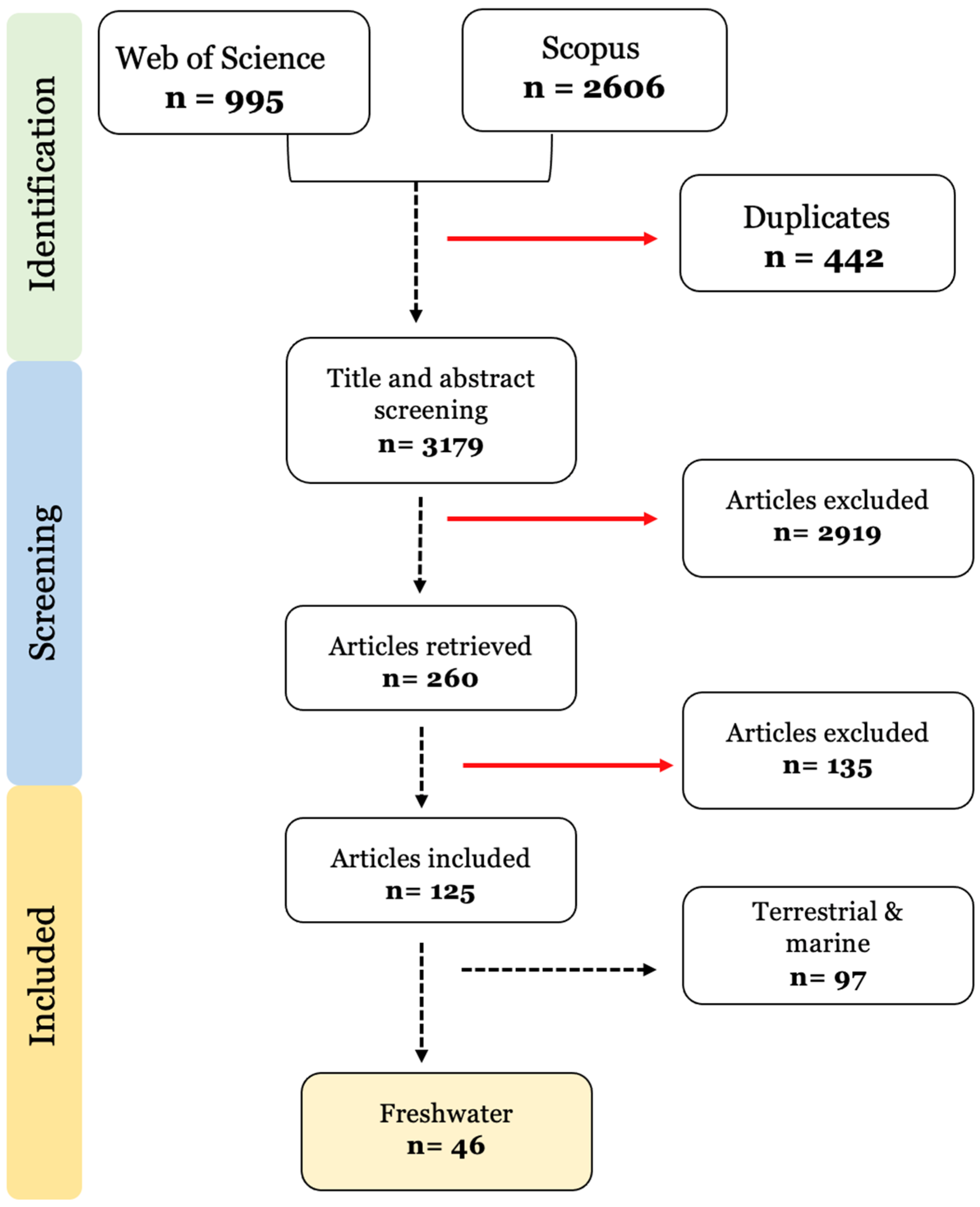
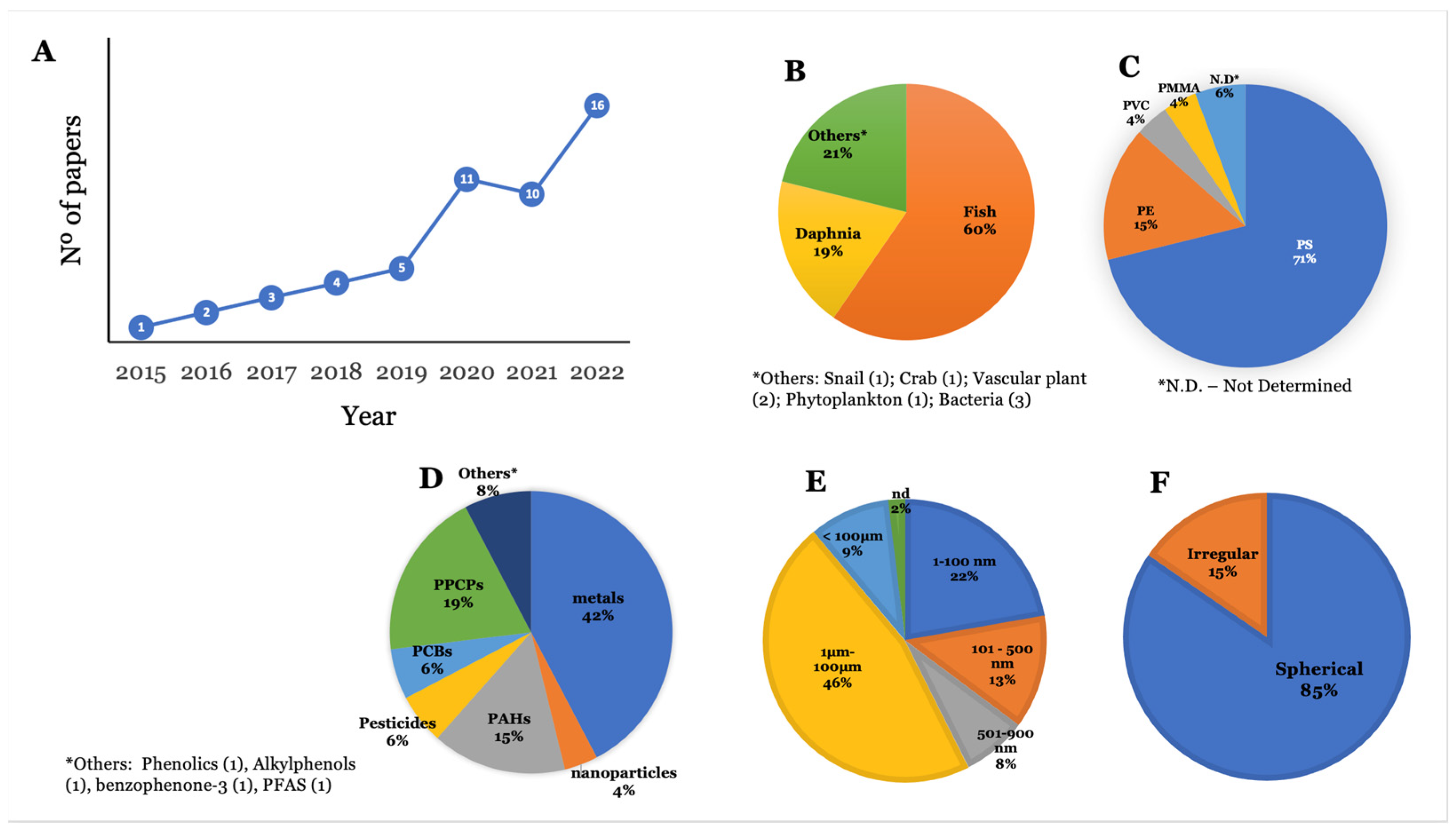
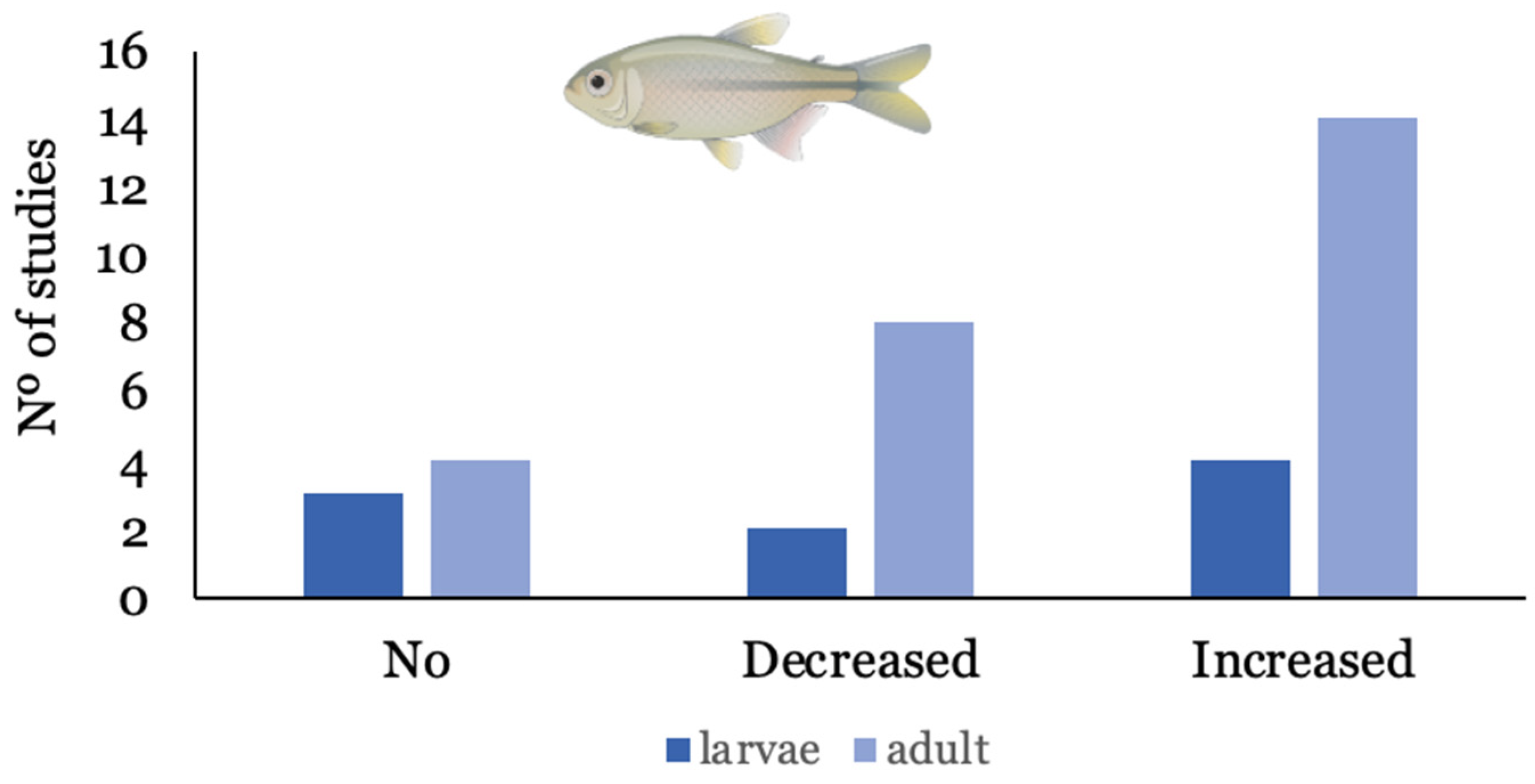
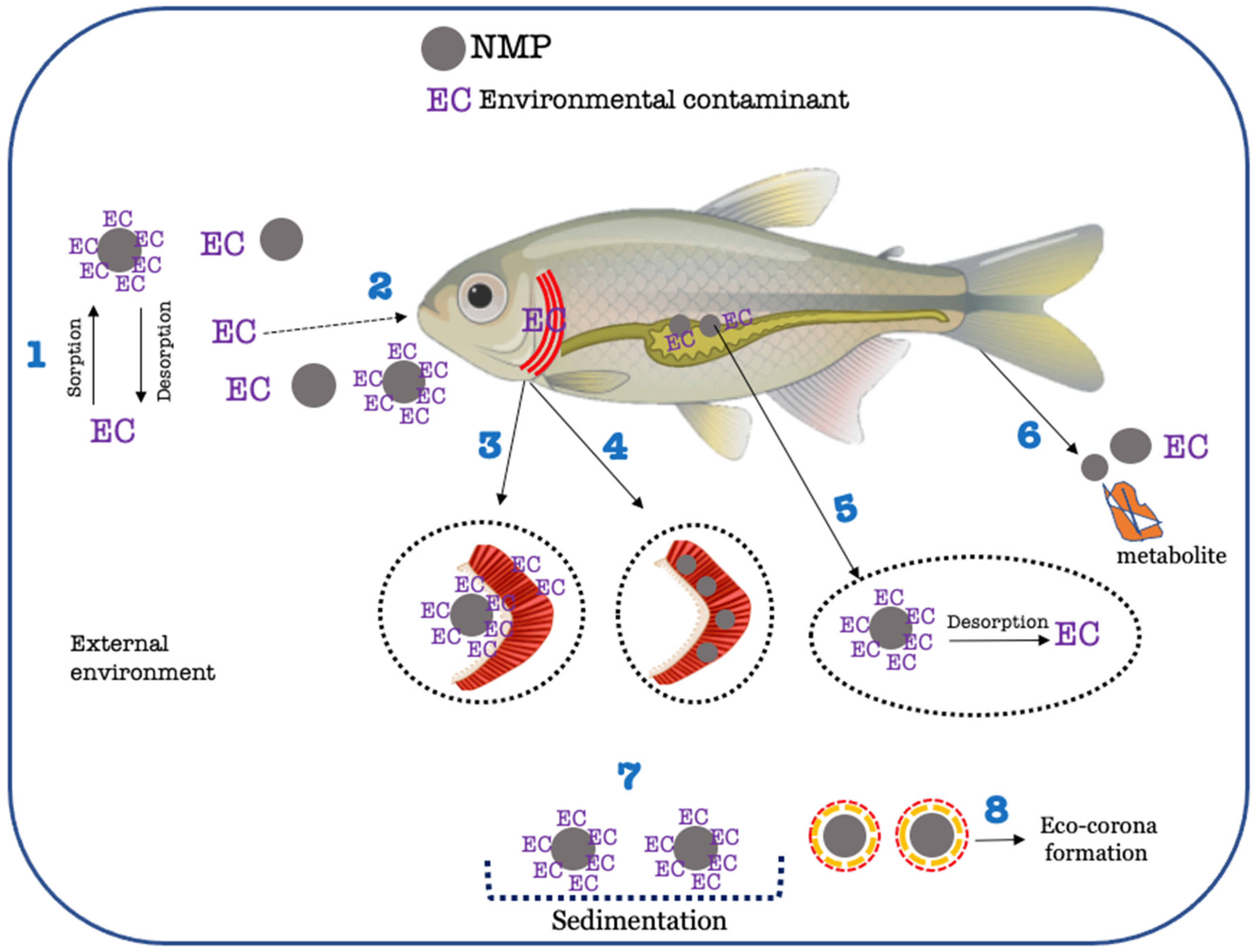
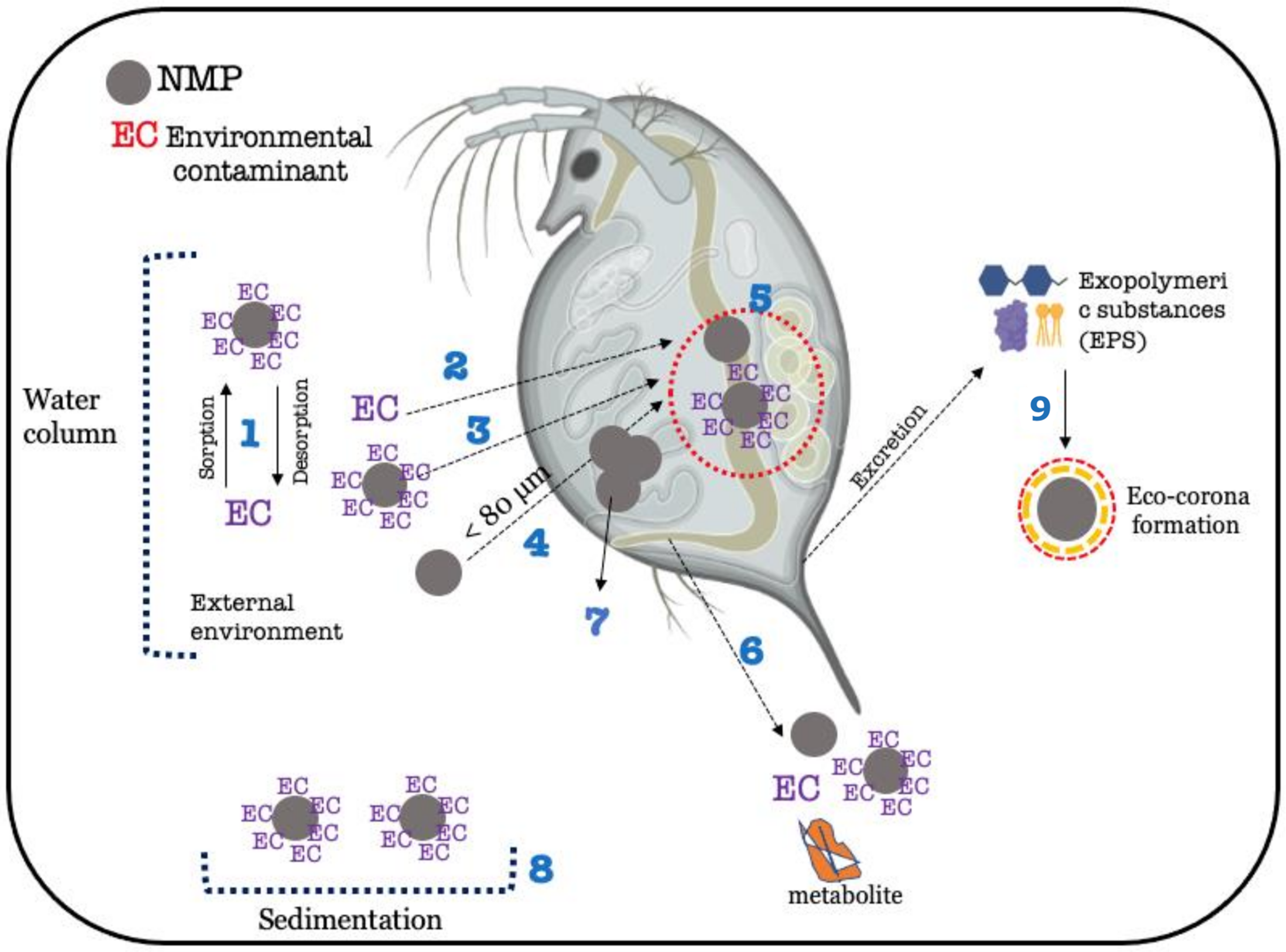
Disclaimer/Publisher’s Note: The statements, opinions and data contained in all publications are solely those of the individual author(s) and contributor(s) and not of MDPI and/or the editor(s). MDPI and/or the editor(s) disclaim responsibility for any injury to people or property resulting from any ideas, methods, instructions or products referred to in the content. |
© 2023 by the authors. Licensee MDPI, Basel, Switzerland. This article is an open access article distributed under the terms and conditions of the Creative Commons Attribution (CC BY) license (https://creativecommons.org/licenses/by/4.0/).
Share and Cite
Ribeiro, F.; Pavlaki, M.D.; Loureiro, S.; Sarmento, R.A.; Soares, A.M.V.M.; Tourinho, P.S. Systematic Review of Nano- and Microplastics’ (NMP) Influence on the Bioaccumulation of Environmental Contaminants: Part II—Freshwater Organisms. Toxics 2023, 11, 474. https://doi.org/10.3390/toxics11060474
Ribeiro F, Pavlaki MD, Loureiro S, Sarmento RA, Soares AMVM, Tourinho PS. Systematic Review of Nano- and Microplastics’ (NMP) Influence on the Bioaccumulation of Environmental Contaminants: Part II—Freshwater Organisms. Toxics. 2023; 11(6):474. https://doi.org/10.3390/toxics11060474
Chicago/Turabian StyleRibeiro, Fabianne, Maria D. Pavlaki, Susana Loureiro, Renato Almeida Sarmento, Amadeu M. V. M. Soares, and Paula S. Tourinho. 2023. "Systematic Review of Nano- and Microplastics’ (NMP) Influence on the Bioaccumulation of Environmental Contaminants: Part II—Freshwater Organisms" Toxics 11, no. 6: 474. https://doi.org/10.3390/toxics11060474
APA StyleRibeiro, F., Pavlaki, M. D., Loureiro, S., Sarmento, R. A., Soares, A. M. V. M., & Tourinho, P. S. (2023). Systematic Review of Nano- and Microplastics’ (NMP) Influence on the Bioaccumulation of Environmental Contaminants: Part II—Freshwater Organisms. Toxics, 11(6), 474. https://doi.org/10.3390/toxics11060474








